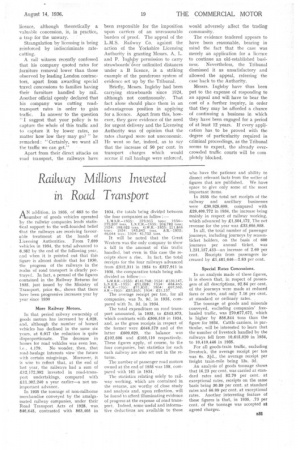Railway Millions Invested
Page 37

If you've noticed an error in this article please click here to report it so we can fix it.
in Road Transport AN addition, in 1935, of 683 to the number of goods vehicles operated by the railwily companies lends statistical support to the well-founded belief that the railways are receiving favourable treatment at the hands of 1.icensing Authorities. From 7,699 vehicles in 1934, the total advanced to 8,382 by the end of the following year, and when it is pointed out that this figure is almost double that for 1930, the progress of the railways in the realm of road transport is clearly portrayed. In fact, a perusal of the figures contained in the Railway Returns for 1935, just issued by the Ministry of Transport, price 6s., shows that there have been progressive increases year by year since 1930
More Railway Motors.
In that period railway ownership of goods motors has increased by 4,028, and, although the number of horsed vehicles has declined in the same six years, at 6,017 the reduction is quite disproportionate. The decrease in horses for road vehicles was even less, i.e., 4,179. No wonder, .then, that road haulage interests view the future with certain misgivings. Moreover, it is wise to reflect that, at the end of last year, the railways had a sum of £12,172,392 invested in road-transport undertakings, compared with £11,302,240 a year earlier—a not unimportant advance.
In 1935 the tonnage of non-railborne merchandixe conveyed by the amalgamated railway companies, under their Road Transport Acts of 1928, was 846,645, contrasted with 863,405 in 1934, the totals being divid,ed between the four companies as follow :—
L.m.s.a.-1935: 379,953 tons; 1934379,207 tons. L.N.E.R.-1935: 208,782 tons; 1934: 198,622 tons. G.W.R.-1935: 211,866 tons; 1934: 243,843 Lona. S.1l.-1935: 46,044 tons; 1934: 41,733 tons.
It will be noted that the Great Western was the only company to show a fall in the amount of this traffic handled, but even in this case the receipts show a rise. In fact, the total receipts for the four railways advanced from 4312,311 in 1934 to £327,911 in 1935, the comparative totals being subdivided as follow: — L:M.S.R.-1935: 4141,768; 1934: 4139,147. L.N.E.R.-1935: 491,028; 1934-: 484,465. G.1,‘ .R.-1935: 471,852; 1934: £67,562. S.R –1935: 423,263; 1934: 421,137.
The average receipt per ton, for all companies, was 7s. 9d. in 1935, compared with 7s. 3d. in 1934.
The total expenditure on road transport amounted, in 1935, to £543,973, which contrasts with £506,510 in 1934, and, as the gross receipts in respect of the former were £646,579 and of the latter £609,620, the balance was £102,606 and £103,110 respectively. These figures apply, of course, to the four companies, but statistics for each each railway are also set out in the returns.
The number of passenger road motors owned at the end of 1935 was 158, compared with 161 in 1934. " The statistics relating solely to railway working, which are contained in the returns, are worthy of close study and analysis and, upon reflection, will be found to afford illuminating evidence of progress at the expense of road transport. Indeed, some useful and informative deductions are available to those who have the patience and ability to dissect relevant facts from the welter of figures that are published. We have space to give only some of the most important items.
in 1935 the total net receipts of the railway and ancillary businesses were 430,928,609, compared with £29,409,772 in 1934, the increase being mainly in respect of railway working, which advanced by £1,504,172. The net revenue for the year was £33,695,058.
In all, the total number of passenger journeys, including journeys by seasonticket holders, on the basis of 600 journeys per annual ticket, was 1,231,157,433—an increase of 2.60 per cent. Receipts from passengers increased by £1,481,646-2.83 per cent.
Special Rates Concessions.
In an analysis made of these figures, it is shown that, in respect of passengers of all descriptions. 92.84 per cent. of the journeys were made at reduced fares or rates, and only 7.16 per cent. at standard or ordinary rates.
The tonnage ot goods and minerals conveyed, excluding companies' freehauled traffic, was 270,4377,672, which is higher by 856,844 tons than the figure for 1934. Cattle carriers, in particular, will be interested to learn that the number of livestock handled by the railways fell from 10,615,020 in 1934, to 10,410,446 in 1935.
For all goods-train traffic, excluding livestock, the average receipt per ton was 6s. nd., the average receipt per freight train-mile being 13s. 3d.
An analysis of goods tonnage shows that 16.23 per cent, was carried at standard rates and 82.70 per cent, at exceptional rates, receipts on the same basis being 30.89 per cent, at standard rates and 66.09 per cent, at exceptional rates. Another interesting feature of these figures is that, in 1935, .73 per cent, of the tonnage was accepted at agreed charge.












































































